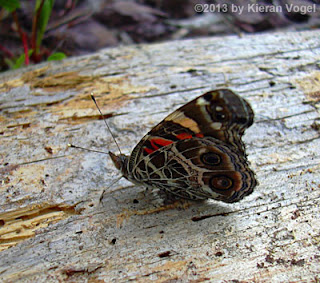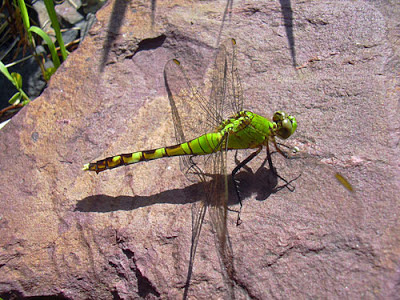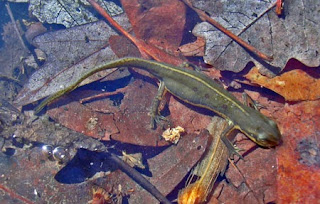Grab a cup
of coffee and a snack or 2 and plan for a long read. This runs on a bit longer than
I originally planned!
This is the
hardest nature blog I’ve written so far! Why? Because the day I got the bright
idea to do a photographic survey of the butterflies that come through our yard
we were hit by a punishing heat wave with temperatures in the upper 90s! So lately
I’ve been running around in the blazing sun like a mental patient with my $1.27
butterfly net (thank you local Odd Lot) chasing down anything the flutters!
The problem
is that although we have a plethora of dragonflies we really only get 5 or 6 butterflies
passing though each day. Many of the critters I saw flitting around the flora and
foliage turned out to be this moth!
What kind it
is I have no idea but they are everywhere and near impossible to swoop up! (and
kinda ugly) The few really attractive butterflies that zig-zag by only get within
reach for a few seconds and then head up over the house and then deep into the tree
line. But I kept trying! After almost collapsing one day from heatstroke
(seriously) I was able to grab this photo of a very elusive species!
Behold Fictus
papilio! Um…anyone buying this? No?
OK…it was worth a shot!
Father: Does anyone know where the butter is?
Son: I needed it for my blog!
Father: What!??
Son: Never mind.
OK, that’s enough with the shenanigans! Luckily I was
able to snare a one or two specimens to share with you here! (for real) Once I
netted them I was able to very gently place them down somewhere in the shade
and snap a picture or two before they flew off!
This sort of mothy looking fellow (butterfly purists
would kill me for saying that) is the “Cabbage White” (Pieris rapae.)
male
They are found throughout North America and are only
about 30-50mm across. This one’s entire
wingspan is just a bit larger than a quarter. Admittedly, he looks a little
ragged but that’s not my fault! I was very gently with him! And he is a “him”
by the way, the female’s
forewing has two black spots and the male, like this one, has only one.
male
Here is a female (below) that I was lucky enough to spot while I was
sitting out on my front porch doing the spellcheck on this blog!
female
The Cabbage
White’s caterpillars favor
cabbage (imagine that!) but eat many other crucifers and related plants. And to be clear, “crucifers” are plants belonging to the
mustard family . . . didn’t want any of you thinking I was getting all religious
on you all of the sudden!
I also found this tidbit on-line, “Introduced
accidentally near Montreal in the 1860s, this species has become an important
pest.”
Wow! OK…I guess we’ve all had enough of Mr. Cabbage then! Moving right
along!
Now this even tinier fellow, just over an inch, is the Eastern Tailed-Blue (Cupido comyntas) which is found throughout southern
Canada and most of
United States except in Stroudsburg where I see 1 like every 6 days if I’m
lucky!
By the way, Does that flow, “Eastern Tailed-Blue ?” Shouldn’t they have called the thing “The
Blue-Tailed Eastern?” Maybe it’s like “The
Surgeon General” instead of “General Surgeon?” Now I’m just confusing myself. Skip
it!
So, I’m pretty sure this is a male because there is only
one orange spot on each wing (females have 2-3) but he certainly wasn’t a looker!
Some of this species are a bright, brilliant blue but this one was more subdued
with a goodly amount of gray and brown mixed in. Hey, I photograph what I can
get!
He was actually reluctant to leave the net once I set him
free! I think he was actually beginning to tame out towards the end!
I have read on-line that in its caterpillar stage this
butterfly feeds on Cow Vetch but I found him perched on Crown Vetch so I think
it’s probably safe to assume they are able to make do with whatever’s
available. And after all, remember what mother butterfly always said, “Eat your
vetches!” (Couldn’t resist…sorry!)
Seeing them all together like this really makes it look like
I live in butterfly country but it’s been several days between each one I
netted and photographed…not to mention the ones I netted that took off
before I could even get my cheapo camera to focus! Grrrr...
Now, this beautiful creature is, I’m pretty sure, (Vanessa
virginiensis), the “American Painted Lady” or just “American Lady” or “Painted Beauty”
or “Hunter's Butterfly” (don’t know
how that last name fits in!)
It's found in most of
North America south to Columbia and Venzuela favoring higher elevations. It has
even established itself on the Canaries (um...the Spanish islands off the coast of
Africa, not the birds) and in Hawaii.
In my field guide from 1992 it says it was “Formally
assigned to the genus Vanessa” and they call it “Cynthia virginiensis” but on
most modern websites, including Wikipedia, it is STILL assigned the genus
“Vanessa.” Hunter, Beauty, Painted, Not
painted, Cynthia, Vanessa…this name stuff just makes me nutty! Who knew a study
in butterflies could become so befuddling…butterfuddling even! “Butterfuddling?”
That doesn’t sound good.
Here is the one shot I was able to grab when it (he? She?)
opened up for just a second before taking flight! I’d say from wing tip to wing
tip was about 2”.
It may look dangerous,
by the way, but if you don’t bother them, they won’t bother you! Huh? Oh…that’s from an upcoming snake
blog…sorry! My desk is such a mess…notes all over the place!
This, without
doubt, was the most difficult butterfly to scoop up. I mean this thing was erratic
and zany fast! I was literally out there cooking in the heat for almost 2 days
before I chased one into the woods and snatched it when it whirled ‘round to
speed past me again! This is the Great Spangled Fritillary (Speyeria cybele) the most common
fritillary throughout most of the eastern United States.
I love that
name “Fritillary” which the dictionary says is derived from
“ fritinnire
"to twitter," Imitative of the rattle of dice. The butterfly is so
called perhaps from resemblance of its markings to those of dice…”
Hey, there’s your
chance folks! TWITTER is huge, right? Someone needs to come along now with
“FRITINNIRE.” You're welcome!
Great Spangleds
have a wingspan of 2 1/2 - 4 inches. I’d
say this one was about 3”.
Adults eat nectar from many species of flowers
including milkweeds, thistles, mountain laurel, and, you guessed it, vetch!
We’re like Vetch Central around here…I’m surprised we don’t get more of them!
And now for
some more butterfly naming weirdness. This yellow gem is called the Orange
Sulphur or the Alfalfa Butterfly (Colias eurytheme).
These small butterflies, 1 3/8 – 2 ¾ inches, are one of the most widespread and common in North America except in Florida where, for whatever reason, they
don’t exist! The orange parts are on the
upper wings and you can sort of see it here if you squint your eyes while you
look at the picture.
Mike Reese
notes on his excellent site “Wisconsin Butterflies” that the,
“orange on the
top of the wing of the Orange Sulphur is very evident in flight, especially in
summer individuals which seem to have more orange.”
He also states,
“It was very difficult to get a photo that clearly shows
the orange on the upper wings. After years of trying, I finally found one that
was so dark orange on top that it was very evident from below.”
Not sure I
entirely understand that remark except that it illustrates how dominant the
yellow is and that I’m probably lucky to have even slightly captured that subtle coloring in my first attempt!
And check out this photograph! This is cool because you can see the Sulphur’s
tongue! (Actually called its Proboscis) That’s the coiled, spirally looking thing
hanging in front that it uses to sip nectar from flowers.
OK,
have you had enough of the butterflies? More than enough? Yeah, well this went
a little longer than I anticipated. Like I suggested I hope you made coffee and had a few snacks on hand!
To reward you for your stick-to-it-ive-ness I present you lastly and
finally with (Papilio polyxenes asterius) the Eastern Black Swallowtail or
Black Swallowtail (sans the Eastern) or Parsely Swallowtail or American
Swallowtail. Well you just knew by now there’d be way to many names, didn’t
you!??
This
is the only one of its kind I’ve seen on our spit of property here in the
Poconos. I didn’t even have to chase this one down! It just drifted down on
some Bull Thistles near our porch! This was a large 3 ½” butterfly. I’m
guessing because of the small size of its yellow spots and the large patches of iridescent blue that
this was a female.
And yes, those spots were a vibrant pale yellow. (as vibrant
as a pale color can be) My bargain-bin digital camera in no way does its true
colors justice.
OK,
guess what? You survived! You made it to the end of the longest blog I’ll
probably ever subject you too! Please forgive me and I promise our next outing
together will be a much briefer experience!
Any questions, comments, suggestions or maps to buried treasure are
always welcomed!
Thanks a bunch for stopping by and be sure to check back soon for the next installment of Kieran’s Critters!












































